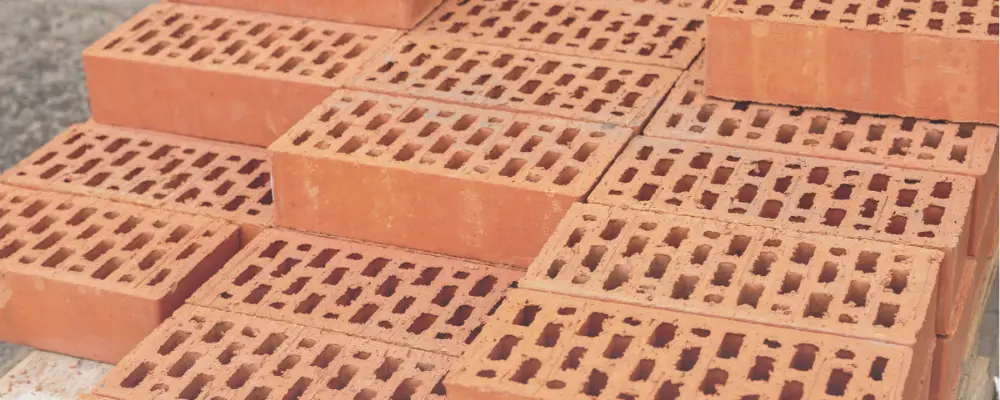Bricks are the most fundamental material used in building construction. They provide impeccable stability and support for the structures, from ancient to modern buildings. However, most people are unaware of the available types in the market, which include concrete bricks, red bricks, calcium silicate bricks, red bricks, etc.
You can explore and choose the appropriate brick type to construct your dream home or other buildings. Because brick is a one-time investment, it needs extra attention to ensure the strength of the overall structure. With rapid technological advancements, new construction materials are often produced. One among them is red hollow bricks.
Let’s continue the reading to discuss in detail hollow bricks, their applications, advantages, and the manufacturing process.
What are Red Hollow Bricks
Red hollow bricks are a popular choice in the construction industry. They are lightweight materials composed of natural clay and other additives, including rice husk ash, sawdust, fly ash, and coal ash.
They are also referred to as breeze bricks or perforated bricks, having holes or hollow spaces that contain at least 25% to 60% of their bed area. The hollow core between the brick reduces the overall weight. Red hollow bricks have been used in several applications due to their unbeatable advantages.
Applications of Red Hollow Bricks
Red hollow bricks are versatile and can be used in a wide variety of applications. Here are some of those:
Structural Applications: Naturally, the red hollow bricks are strong and durable, suitable for constructing load-bearing walls in residential, industrial, and commercial buildings. Because they are less heavy, they are used to create internal partitions within the construction. They support slopes and prevent the occurrence of soil erosion.

Landscaping: Hollow bricks are incorporated with decorative features, which help achieve the desired landscaping designs for raised beds, garden walls, retaining walls, and other ornamental structures. They can be used for creating driveways, patios, and pathways.
Decorative Elements: Red hollow bricks are an ideal choice for accent walls and decorative elements. They offer unique colour and texture to the surface, improving the overall aesthetic value of the building.
Manufacturing Process of Red Hollow Bricks
The manufacturing process plays a vital role in determining the actual quality and strength of the brick while using it in the construction. Even a small error can cause costly defects in the structure. Let’s get into the process:
Right Selection of Raw Materials: The selection of the right raw materials is a crucial stage of the manufacturing process. Clay is a primary resource, extracted from mines or pits. Depending on the specific project requirements, the other materials like lime, sand, and related additives are added.
Clay Preparation: Clay preparation is the next significant step, which involves crushing and grinding the raw materials into a fine powder. It is then mixed with water in precise proportion to achieve uniform consistency.
Moulding: The homogenous mixture is then transferred into the moulds, which are made of steel or wood. They are available in various shapes and sizes; you can choose the one that fits your construction needs. Moulds determine the size and shape of the bricks that you find in the market.
Curing: The curing process involves the moulded bricks being cooled down at a controlled temperature. They are left for a certain time to develop their complete strength and durability. The manufacturing process of bricks decides the type of curing required, which is either steam curing or water curing.
Demoulding: After the curing process, it is time to demould the bricks. They are now ready to be used in construction.
Properties of Red Hollow Bricks
These are the significant properties of red hollow bricks:
Strength: Red hollow bricks have a high compressive strength and are resistant to harsh weather conditions. They are capable of handling significant loads and weight from the overall structure.
Weight: Red hollow bricks are lighter than solid bricks, reducing the overall weight of the structure. They are lightweight and easy to transport, handle, and install in the construction.
Size and Shape: There is no defined size and shape for the red hollow bricks. They can vary depending on the mould size and shape used in the manufacturing process. Thus the builders can customise the standard size or shape according to specific needs.
Thermal Insulation: The hollow spaces within the bricks offer excellent thermal insulation, which creates a comfortable indoor temperature in harsh weather conditions. It significantly saves the cost spent on heating and cooling.
Advantages of Using Red Hollow Bricks
Red hollow bricks have several advantages, such as:
Lightweight: The hollow spaces in the brick reduce the overall weight and make it easy to use. It is typically lighter than solid bricks, which simplifies the process of handling, installing, and transporting.
Economical: Red hollow bricks are a budget-friendly choice, as the cost of resources and labour costs are typically lower than other types of bricks. This contributes to long-run cost savings for the property owners or homeowners.
Insulation Properties: The empty spaces that exist in the red hollow bricks act as a natural insulator, serving a comfortable indoor environment within the buildings. It proficiently reduces the heat transfer through walls and improves the overall energy efficiency of the construction. This type of building reduces the costs associated with heating and cooling.
Fire Resistance: Red hollow bricks have enhanced fire resistance properties, ensuring the safety of the people and building. In case of an unfortunate fire accident, these bricks help prevent the fire from spreading throughout the building.
Final Lines
Red hollow bricks are widely used in various construction applications. Due to their balanced strength, aesthetic appeal, and durability, they have become a popular choice for residential, commercial, and industrial buildings. Additionally, these bricks are environmentally friendly, reducing the carbon footprints and contributing to a sustainable environment.

